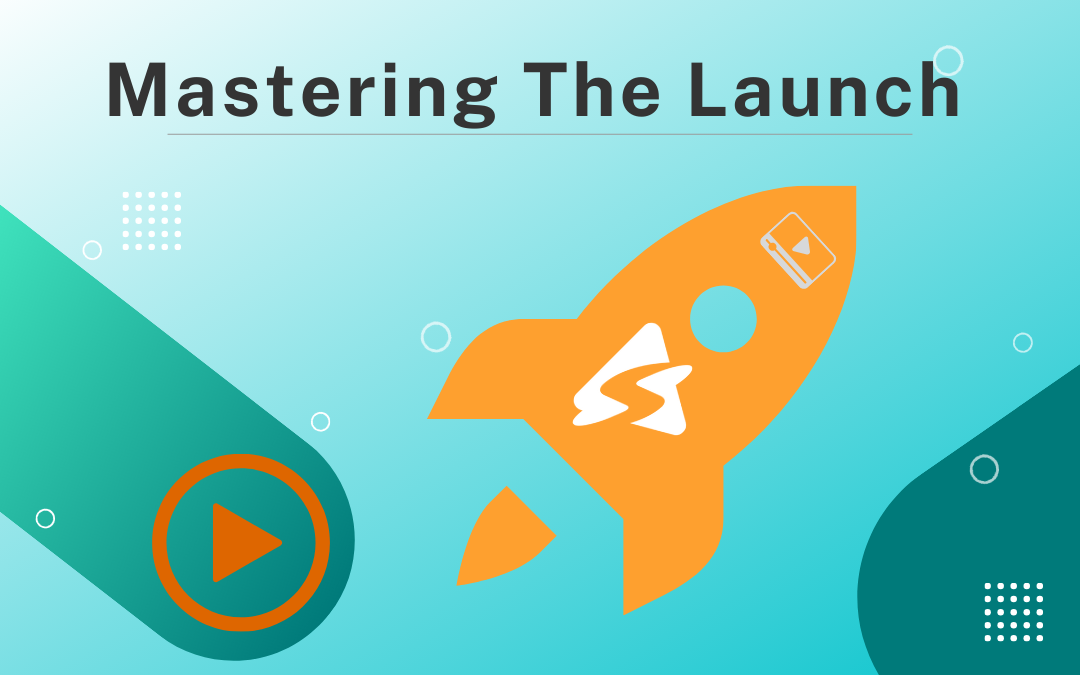Eager to share your expertise through an online course but not sure how to launch an online course? This guide cuts through the noise, offering a clear, actionable path to turn your knowledge into a comprehensive online course.
We’ll walk you through identifying your audience, creating engaging content, choosing the right platform, and effective marketing strategies. Strap in for a no-fluff journey to launching your online course successfully.
How to Launch an Online Course – Key Takeaways
1 – Identify a relevant course idea and understand your target audience’s needs through research and direct engagement, ensuring your content addresses their pain points and interests.
2 – Develop a comprehensive online course outline with clear learning outcomes and a structured format, which is essential for effective delivery and achieving intended educational goals.
3 – Prepare for a successful course launch by creating a captivating sales page and driving traffic to that page using strategic marketing that builds anticipation. Then make sure you use an engaging course platform that makes it easy to continuously gather feedback so you can optimize your course and offer.
Identifying Your Course Idea and Target Audience

Prior to launching an online course, you should have already reviewed your online course ideas to pinpoint the one you want to target. Not only will this ensure engagement and relevance but it will also set the foundation for your online course business.
In many cases the target audience and/or course is already known. Maybe you have knowledge that you know is valuable to a particular audience. Or it could be the other way around, and you know there’s an audience seeking knowledge in a particular field and there are no good solutions.
But what if this isn’t the case? What if you don’t know what kind of course to develop?
One way to start is by searching out areas online where people gather to discuss something you have some interest or some experience in. Places like Reddit or Facebook groups are a good starting point. Start reading their questions and where they find solutions. Find their complaints. These pain points are a good starting point, as you want your course to solve these pain points.
If possible, engage this audience with your own questions. Ask them for a quick chat and find out what they are looking for and why they currently can’t find it. Present polls to the audience to gather more insight about what need.
And remember, you aren’t necessarily looking for an area with no competition. Competition can be good as it means there are businesses already succeeding. You just need to fill the gaps that competitors aren’t filling and position your course in different way than they do.
Discovering Your Course Topic
After making the decision to launch an online course, it becomes vital to uncover a profitable course topic. Building on what we just discussed, let’s get into some more ways you can find a profitable course topic and sell online courses:
Start by listing down marketable skills and interests. What are you good at? What do you have experience with? Do you have anything you are passionate about?
Analyze what’s popular on online marketplaces. Remember, competition is a good thing. Check to see if there are any courses that you believe you can improve on. Don’t be afraid to buy some courses to analyze them and see what they are missing.
Combine your personal experience and the willingness of the target audience to pay for it. What value can you add, and how much of it, to create a course that will be desirable?
By following these steps, you can find a course topic that is both profitable and aligned with your skills and interests.
Researching competitors can help you uncover gaps or new angles in existing courses, thereby carving out a niche for your course offering. Are there popular courses that are all fairly general that you can build on to get more specific and more advanced? If that’s the case, you already have a market of people that went through what is currently offered and now needs more.
Either way, it’s crucial to ensure the course topic is both focused and relevant. Understand the target audience’s needs and interests and consider areas where you can provide meaningful solutions to problems. This way, you’re not just launching an online course but also providing a solution that your target audience has been seeking.
Validating Market Demand
Validating market demand is a crucial step in creating a successful online course. It involves researching your target audience and understanding their needs, preferences, and pain points. Here are some ways to validate market demand:
1 – Conduct Online Research: Use tools like Google Trends, Keyword Planner, and social media to understand what people are searching for and talking about in your niche. This will give you insights into popular topics and emerging trends that can inform your course content.
2 – Survey Your Audience: Create a survey to gather information about your target audience’s needs, preferences, and pain points. Use platforms like SurveyMonkey or Google Forms to distribute your survey and collect responses. This direct feedback will help you tailor your course to meet the specific needs of your audience.
3 – Analyze Your Competition: Research your competitors and identify gaps in the market that your course can fill. Look at their course offerings, pricing, and customer reviews to understand what they are doing well and where there is room for improvement. This will help you position your course uniquely in the market.
4 – Create a Minimum Viable Product (MVP): Develop a basic version of your course and test it with a small group of students to gather feedback and validate demand. This will allow you to make necessary adjustments before launching the full course, ensuring it meets the needs of your target audience.
By validating market demand, you can ensure that your online course meets the needs of your target audience and has a high potential for success.
Analyzing Your Target Audience
It’s important to discuss your audience a bit more. Grasping the nuances of your target audience is just as important as pinpointing your course topic. As mentioned earlier, if possible try to survey your target audience to understand their professional challenges and desires and how your course can address these needs. If necessary, offer an incentive to participate.
Direct interactions with potential learners are essential to ensure the course content matches their expectations and skills or knowledge they are seeking.
Building Your Course Content and Outline
Developing a lucid and comprehensive course outline serves as a roadmap for the creation of an online course, methodically leading both instructors and students through the content. Creating a detailed course outline before content creation can save you a lot of time and headaches.

An effective course outline should include:
1 – Lessons and training modules: Don’t worry if this isn’t exhaustive to start. Start with what you know, then build out as you perform the steps below.
2 – Lesson objectives and descriptions: Clarifying this will help you build out the lessons more completely without repeating anything.
3- Content type: Video or text or both. Will you provide any downloadable content like PDFs?
4 – Practical tasks: Will you require any tasks to be performed before or after the lesson?
5 – Assessments: Will you rquire or quizzes or tests after any lessons or modules?
6 – Timing for each segment: Are there timing requirements or due dates for each lesson or assessment?
Gathering information about learners’ previous training experiences can inform the course design, ensuring the content and delivery methods are appropriate. This way, your course content will not only be comprehensive but also tailored to your audience’s needs.
Establishing Clear Learning Outcomes
Setting out defined learning objectives can serve as a guiding path for both instructors and students, fostering a mutual comprehension of the course’s objectives.
But how do you establish clear learning objectives?
Start by defining the overarching, main goal of the course. Extablishing this first and making it very clear ensures that all goals and leanring outcomes are alsigned with the larger course purpose and make sense.
Learning objectives should be defined clearly for each lesson to guide the creation of content and activities that help learners achieve specific outcomes. Use actionable verbs in your objectives to make them tangible and measurable, aiding in the assessment and reinforcement of the learning experience.
Objective statements should be precise and actionable, clearly describing what students will be able to do after completing the course, and avoiding vague or general statements. This way, you guide students towards success, ensuring that the learning outcomes are clear and achievable.
Organizing and Structuring Your Course
Having determined your course idea, target audience, and learning outcomes, the next step involves organizing and structuring your course. Ensuring that course objectives are aligned with activities, assignments, and assessments is essential for a focused and well-structured course. Organize your course into modules and lessons that progressively guide learners toward the end goal, presenting a coherent structure of the subject matter.
By structuring content with modules, instructors can control content order and track student progress, helping students easily follow the intended course sequence. Modules can include a diverse array of items, such as assignments, quizzes, and videos, and can be integrated with third-party tools to enhance interactivity. A strong visual hierarchy with chunked content facilitates a predictable and logical sequence for learners, enhancing content consistency.
This way, you not only provide a structured learning path but also enhance content consistency and usability for your students.
Creating Your Course
We’ve dedicated nn entire series to creating your own course which you check here. This part of your journey will of course be crucial to the success of your business. As discussed in his series, creating the complete course and building it does not need to come first. The marketing steps discussed in that series as well as this article can be started and should be started.
To get off the ground runnin gyou can start with lesson and video outlines for what topics you will cover in each text less and video lesson. Performing this step can help clear any sense you have that you are overwhelmed with activities. Small steps is the key to building your course business.
Designing an Engaging and User-Friendly Online Course Platform
Developing an engaging and intuitive online course platform plays a pivotal role in a successful online course launch. There are dozen of options available. The best platform to host online courses for you might be different than for others. An intuitive layout and consistent design elements are important so that students can quickly understand the structure of the learning materials.
It’s also nice to have well-designed tools and options so that you can increase learner engagement with the material and the instructor. When students feel like they can engage well it helps motivate them to really absorb the material and hopefully reach the learning outcome you have set.

Choosing the Right Online Course Platform
Selecting the appropriate online course platform is an important step but not as vital and some make it seem. Your needs will likely change hence your platform will change. We are not suggesting you pick anything, but pick what makes sense for your current goals, not goals you ‘may’ have in a year or two.
With numerous online course platforms available, a robust online course platform must support a minimum of text and video lesson formats. Other learning formats like audio, webinar, and live workshops may not be something needed immediately and can be added later. Those can also be added as supplementary platforms to your main learning platform.
Your main decision here will be whether to use a more customizable set up like WordPress with some sort of LMS plugin or theme, or to use a ‘done for you’ platform SaaS like Teachable or Thinkific. There are advantages and disadvanteges to any of these.
There are quite a few choices to make when deciding on your platform, and as mentioned you will likely change and switch over time as your needs change and your business changes. Here are a few options with a comparison of each platform to get your started:
1 – Kajabi vs ClickFunnels (SaaS)
2 – LearnDash vs LifterLMS (WordPress)
3 – Teachable vs Thinkific vs Kajabi
For example, you may be considering using WordPress with an LMS plugin like Learndash and comparing that with a SaaS platform like Teachable. When considering Learndash vs Teachable your biggest considerations will be simplicity VS customization and time VS money.
Each platform will have different options for stuff like analytics, gamification, branding, enrollment and added costs. Self-hosted platforms like WordPress generally offer more customization and options, but come at a cost of time and effort of set-up. While full-service SaaS platforms like Teachable offer quicker and easier set-up but at the cost of less options and less customization.
Customizing Your Platform for Brand Consistency
Tailoring your platform for brand consistency is an imprtant consideration we’d like to single out. Your brand can separate you from the competition and creates a holistic feel for your who you are and what you offer. Maintaining visual consistency in eLearning design brings an intuitive feel, reducing cognitive load and focusing learners on the content rather than navigation.
No matter which platform you choose to deliver your course, you should aim for a harmonious design with balanced visual elements. That means using a cohesive color scheme and repeated icons, typefaces, and buttons, all of which can lead to enhanced usability and a more intuitive course interface.
Of course that doens’t mean you need to be 100% on-brand at all times. It can be not only fun but effective to go off-0brand. Strategic inconsistencies can be used sparingly to draw attention to critical material and highlighting new offers or new content.
Here’s the big takeaway…stay on brand but keep it fun and fresh!
Developing Your Online Course Business
Developing your online course business involves creating a comprehensive plan for creating, marketing, and selling your online course. Here are some key steps to consider:
Define Your Business Model: Determine how you will create, market, and sell your online course. Will you offer a subscription model, one-time purchase, or a combination of both? Understanding your business model will help you plan your marketing and sales strategies effectively.
Identify Your Target Audience: Understand who your ideal student is and what their needs, preferences, and pain points are. This will help you create a course that is tailored to their specific needs and increase the likelihood of success.
Create a Unique Selling Proposition (USP): Develop a unique value proposition that sets your course apart from others in the market. What makes your course different and why should students choose it over others? Highlighting your USP will help you attract and retain students.
Develop a Marketing Strategy: Create a plan for promoting your course to your target audience. This could include content marketing, social media marketing, email marketing, and paid advertising. A well-rounded marketing strategy will help you reach a wider audience and drive enrollments.
Establish a Pricing Strategy: Determine how much to charge for your course based on its value and the competition. Consider offering different pricing tiers to accommodate different levels of demand and willingness to pay. A well-thought-out pricing strategy will help you maximize revenue and attract a diverse range of students.
By developing a comprehensive plan for your online course business, you can ensure that your course is successful and profitable.
Establishing Your Pricing Structure
Understanding how to price your online course can be tricky. Here are some factors to consider:
Value-Based Pricing: Determine the value that your course provides to students and price it accordingly. Consider the outcomes and benefits that students will gain from your course and set a price that reflects this value.
Competitor-Based Pricing: Research your competitors and price your course competitively. Look at what similar courses are charging and position your course within that range. This will help you attract students who are comparing different options.
Cost-Plus Pricing: Calculate the costs of creating and delivering your course and add a markup to determine the price. This ensures that you cover your costs and make a profit. Consider all expenses, including production, marketing, and platform fees.
Tiered Pricing: Offer different pricing tiers to accommodate different levels of demand and willingness to pay. For example, you could offer a basic version of your course at a lower price and a premium version with additional content and features at a higher price. This allows you to cater to a wider audience and maximize revenue.
By establishing a pricing structure that reflects the value of your course, you can ensure that you are generating revenue and attracting students.
Building an Online Community
Building an online community involves creating a space where students can connect with each other and with you. Here are some ways to build an online community:
Create a Private Facebook Group: Create a private Facebook group where students can connect with each other and ask questions. This provides a platform for students to share their experiences, seek advice, and build relationships.
Use a Community Platform: Use a platform like Discord or Slack to create a community space for students. These platforms offer various features like chat rooms, voice channels, and file sharing, making it easy for students to interact and collaborate.
Host Live Events: Host live events, such as webinars or Q&A sessions, to connect with students and build a sense of community. Live events provide an opportunity for real-time interaction and engagement, making students feel more connected to the course and each other.
Encourage User-Generated Content: Encourage students to create and share their own content, such as blog posts or videos, to build a sense of community. User-generated content fosters a collaborative learning environment and allows students to showcase their knowledge and skills.
By building an online community, you can create a loyal following of students who will support and promote your course.
Preparing for Launch: Marketing and Sales Strategies
Having created your course content and designed your platform, the next step is to get ready for the grand launch. Developing a marketing and communications strategy is key to creating buzz and excitement for the course launch. Basic marketing tools integrated into the platform can attract students without excessive reliance on external resources.
Email marketing tools such as Mailchimp and ActiveCampaign are recommended for launching courses and building the audience. Building a strong email list is a suggested method for spending time effectively to ensure a successful course launch. Remember, it’s important to promote your course to sell it to an audience and drive enrollments, doing so before, during, and after the course launch.

Building an Email List and Pre-Launch Buzz
Compiling an email list and generating pre-launch excitement are essential steps in your course launch checklist. Here are some strategies to consider:
1 – Use lead magnets such as free downloadable resources to grow your email list and validate interest in the course content.
2 – Build anticipation for the course by involving social media, sharing teasers, creating excitement-creating content, and using countdown timers.
3 – Engage potential students by offering exclusive sneak peeks or early access to course materials.
By implementing these strategies, you can effectively build your email list and generate excitement for your course launch.
Nurturing leads through email sequences and offering a free mini-course are strategic ways to introduce the course’s content and benefits. Establishing a social media presence and initiating an affiliate program can significantly extend the course’s reach before the launch. Remember, executing a launch event, like a live challenge or a series of webinars, can effectively announce the new course and simultaneously act as a trigger for sales.
Creating a High-Converting Sales Page
The success of your course sales hinges on your sales page. When you sell courses online you cannot overlook your sales copy and design of the sales page. It’s the first page potential students visit before purchasing the course. Your sales page must be:
– Captivating
– Personal
– Persuasive
– Clear about the course’s value and benefits
An effective sales page should begin with a compelling headline, clearly outline who the course is for, how it will improve their situation, the lessons included, and condense this information into a cogent value proposition. Using high-quality visuals such as header images, course mockups, videos, and consistent design elements enhances the user’s understanding and visualizes the promised outcomes.
Don’t forget to incorporate testimonials and success stories for social proof, fostering trust, and inspiring potential students to enroll.
Executing a Successful Online Course Launch

At last, the day has come! The next step is to implement a successful online course launch. Running a pilot program with a small group can test the course idea and refine it based on feedback prior to the full launch of the first course. Signing up as a test student ensures the enrollment flow and user experience are intuitive and functioning properly.
Utilizing the online course launch checklist ensures all aspects of the course are ready for the public release. Additionally, creating a strategic sales funnel directs potential customers through a process leading to purchasing the course. Remember, a targeted launch strategy significantly boosts online course sales, fostering higher engagement and brand recognition.
Announcing Your Course Launch
The act of announcing your course launch requires a certain finesse. Email marketing is a critical method for announcing an online course launch, with dedicated email sequences that provide information and stir excitement in the existing audience. Incorporating a course link in your email signature can act as a passive yet widespread method to promote the new course to everyday communication contacts.
Social media platforms are effective channels for announcing the course launch, allowing creators to share promotional materials and gather testimonials which can boost registration. Blogs that frequently publish content related to the course topic can be instrumental in turning regular readers into enrolled students when used to promote a new course.
Hosting webinars can not only present the course to potential students but also act as a platform to extend exclusive discounts, thus encouraging sign-ups.
Supporting Students and Gathering Feedback
After the launch, it becomes crucial to provide support to students and collect their feedback. Proactive retention strategies, such as a good onboarding experience and customer support, are pivotal for ensuring customer loyalty and success. Regular involvement by instructors in the classroom, ideally daily, helps to model critical thinking and maintains student engagement.
Creating a community, such as a private Facebook group, where students can interact and network, significantly enhances their learning experience and course completion rates. Collecting direct feedback from students through surveys or community engagement provides insights into user satisfaction as indicated by completion rates and interaction levels. This way, you not only improve your content but also provide personalized support to your students.
Post-Launch Analysis and Optimization
The journey extends beyond the course launch. Analysis and optimization after the launch hold equal importance. Here are some steps to follow for analyzing and optimizing your online course after the launch:
1 – Collect and analyze post-launch performance data to understand how customers perceive and experience the course.
2 – Regularly monitor post-launch data to identify areas for improvement.
3 – Adapt and optimize the course based on the data to improve student learning outcomes and increase sales.
By following these steps, you can ensure that your online course continues to evolve and meet the needs of your students.
Post-launch expectations should reflect the actual behavior of students rather than relying solely on predetermined timelines. After launch, the focus should shift towards value-driven communication, utilizing feedback from early users for marketing content like case studies and testimonials. This way, you not only improve your course but also ensure its success in the long run.
Monitoring Key Performance Indicators
Keeping track of key performance indicators forms an integral part of your post-launch analysis. Monitoring modules and student analytics is critical for understanding student progress and performance, assisting educators in improving content and providing personalized support.
Key sales metrics like:
– Sales Revenue
– Cost per Lead
– Number of Enrolled Students
– Conversion rates from the sales page
are essential indicators of an online course’s popularity and financial success. After the launch, it is critical to analyze a variety of data including website statistics and customer experience metrics to optimize marketing strategies and the overall course offering.
Implementing Feedback and Adjusting Strategies
Post-launch, applying feedback and modifying strategies guarantees continuous enhancement, alignment with student needs, and long-term course success. Using student feedback to revise course content ensures that instructional materials remain relevant and address any concerns, potentially making real-time adjustments to benefit current students.
Adapting marketing strategies based on customer feedback and search behavior is crucial for driving content adoption and enhancing customer satisfaction during the post-launch phase. Continuous product improvement is facilitated by implementing customer feedback and having a clear plan for releasing updated versions of the course, which can sustain and grow the course’s success over time.
Summary
We’ve journeyed through the entire process of launching an online course, from identifying your course idea to post-launch analysis and optimization. Remember, creating an online course is not a one-time endeavour. It’s a continuous process of learning, improving, and growing. By following this comprehensive online course launch checklist, you’re well on your way to launching a successful online course. Here’s to your success!
Frequently Asked Questions
How long does it take to launch an online course?
It really depends on your specific case, but generally, it takes anywhere between 25 to 500 hours to craft an online course. The time needed varies based on factors such as course complexity and your level of experience. Good luck with your course creation!
What is the best way to launch an online course?
The best way to launch an online course is to follow a checklist that includes choosing a course idea, creating the outline and modules, setting up a sales page, post-purchase thank you page, sales emails, and a landing page for a live challenge, and setting up a thank you page for the challenge. This comprehensive approach covers all the essential steps for a successful launch.
How can I find a profitable course topic?
You can find a profitable course topic by listing marketable skills and interests, analyzing online market trends, and considering your personal experience and the target audience’s willingness to pay for it. This will help you identify a topic with great potential for success.
What should be included in a course outline?
Make sure to include training modules, lessons, objectives, content type, practical tasks, assessments, and timing for each segment in an effective course outline. This will provide a clear structure and guidance for the course participants.
How can I create a high-converting sales page?
To create a high-converting sales page, start with a compelling headline and clearly outline the value proposition, including who the product is for and how it will benefit them. Use high-quality visuals and include testimonials and success stories for social proof. Good luck with creating your sales page!
Spotlightr Video Hosting For Your Course
Discover why Spotlightr is the #1 choice for course creators and e-learning professionals.
Register for a free 2 week trial, no credit card required.

